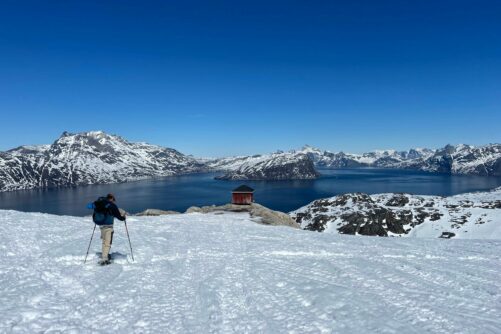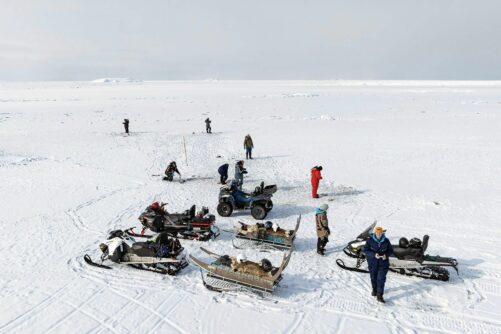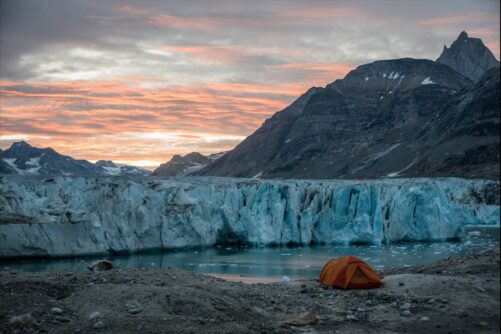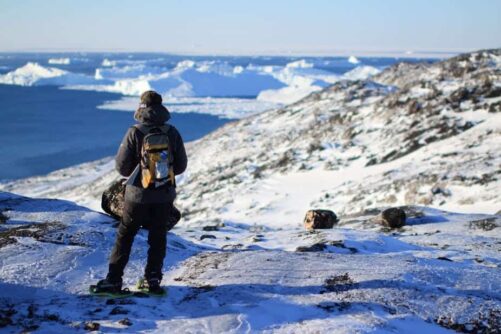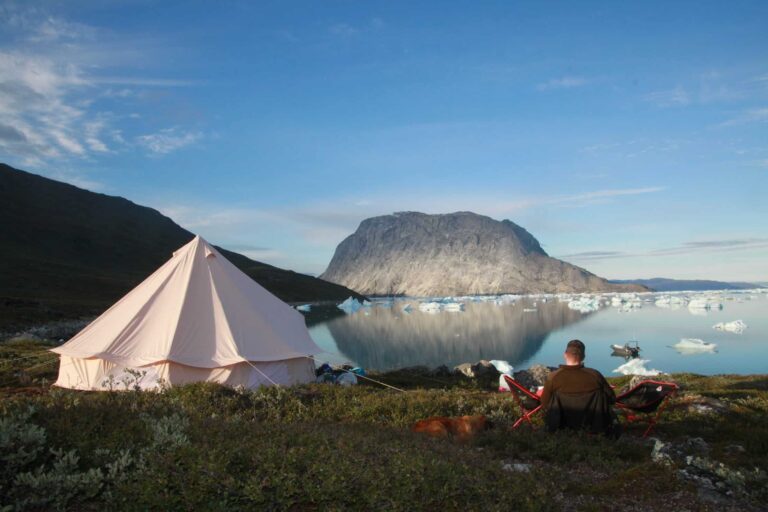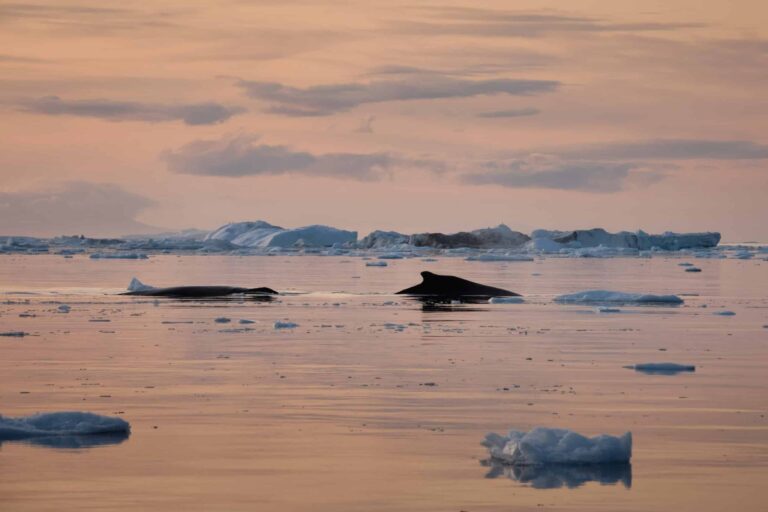

Impressions from a journey in northern Greenland
Jump to chapter
Published: 05/06/2020
Reading time: 5 minutes
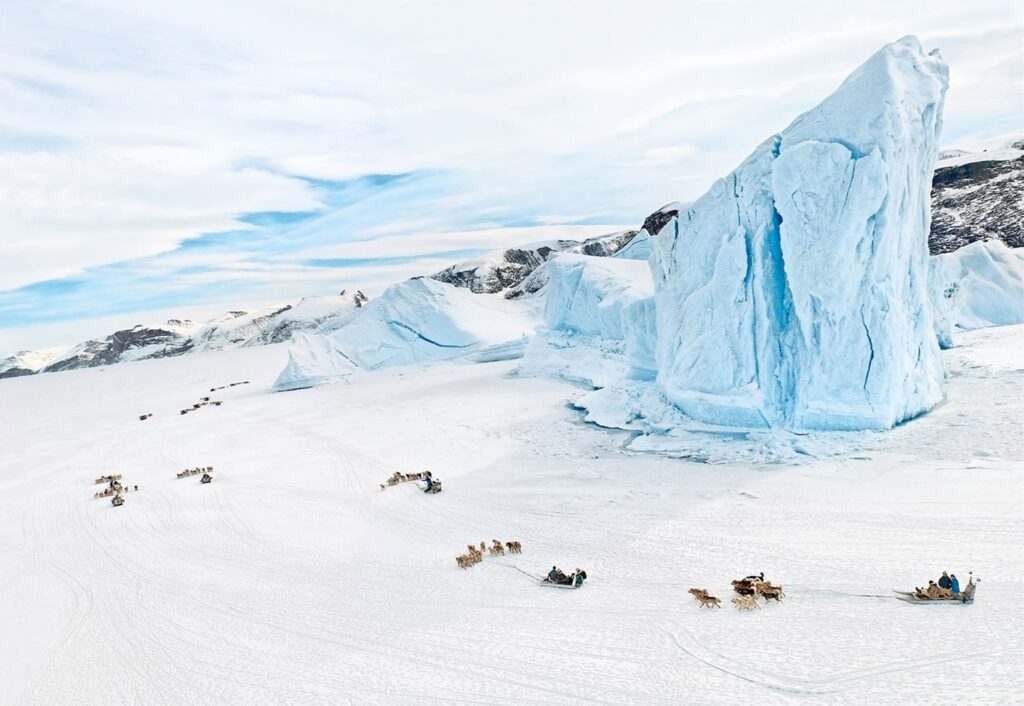
On the trail of Alfred Wegener and Rasmus Villumsen
It feels as though Uummannaq receives travellers with open arms. The harbour is a welcoming place, scattered with colourful houses and, above it all, glowing in the sun towers the reddish mountain, Uummannaq, which means »heart-shaped«. The town is a mixture of old houses from Danish colonial times and modern buildings, like the dominating structure of the town’s school.
Perhaps German travellers in particular associate Uummannaq with the name Alfred Wegener, who undertook a total of four Greenland expeditions. When he came to Uummannaq in 1929 to prepare for his fourth and last expedition, he noticed the special structure the town had at the time. In addition to the colonial houses, there were also houses of turf and in the centre of town there is still a well-preserved house of this type. The town’s rock church wasn’t built until six years later.
Wegener wanted to test his new propeller sled. He had great expectations of it for his expedition, hoping he would be able to travel faster and more easily. He also hoped he would be able to carry a lot more on it, than on a dog sled.
An Arctic pioneer in North Greenland
Seen from a modern perspective and in the light of the climate changes that are greatly affecting Greenland, Alfred Wegener was a visionary pioneer. An important part of his work involved collecting meteorological information. On the Koch-Wegener expedition in 1912, led by the Dane Johann Peter Koch, he drilled holes in the ice. Wegener’s book, »The Climates of the Geological Past« became one of the most important works in the field of paleoclimatology.
Despite being well-prepared, the fourth expedition didn’t get off to a good start. The plan was to have all the material brought across the inland ice in May 1930, but conditions prevented this and the equipment was left for six weeks in Ukkusissat, until it could be transported to the Qaamarujuk glacier; the gate to the inland ice. This delay was partly the reason why the expedition was unsuccessful, resulting in the deaths of Alfred Wegener and Rasmus Villumsen.

The end of the road for the propeller sled – Uummannaq in northern Greenland
At the museum in Uummannaq, where some of the equipment as well as photos and notes from the expedition are exhibited, it is touching to see this part of German polar exploration history. His old propeller sled and his horse-drawn sled are on display in the garden. These were discovered in 1984 on the ice and brought to Uummannaq in 1988. There is also a plaque at the museum.
The museum contains information about the time when marble was quarried at Maarmorilik and about the time when there were still lead and zinc mines nearby. Furthermore, the unique 1972 discovery of the mummies at Qilakitsoq – across from Uummannaq at the coast of Nuussuaq – was documented here and copies of the mummies’ clothing are on show.
The museum alone makes a visit to Uummannaq worth-while, but the town has so much more to offer. There is peace and a magnificent view of fjords, icebergs and mountain chains. No wonder Santa Claus has his summer cottage here. Amongst golfers, Uummannaq has long been a concept; it is here that the »World Ice Golf Championship« takes place each year. Instead of a green, there is a white – but that’s another story.
The settlement of Ukkusissat in North Greenland
Our cruise takes us on to Ukkusissat, which lies 40 km to the north. We are welcomed by 170 inhabitants and 350 dogs. Wegener also made a stop here and he is remembered – perhaps even with pride. This includes his companion, Rasmus Villumsen, who lived here. He was only 21 years old when he died on the inland ice.
Before this, he managed to bury Alfred Wegener, who died in November 1930 on his way back to the West Coast. Villumsen was never found; it is thought that he travelled two days further on the dog sled. In the beautiful, simple church hangs a bronze plaque in his memory. On the plaque, written in Greenlandic and German, it says »In memory of Rasmus Villumsen from Ukkusissat, who together with Alfred Wegener died in the cold and dark in November 1930« .
Back to the future
We are quickly brought back to the present by a group of playing children. They dance polka with gusto and laughing faces, and several of us dance with them, when we are asked. This town looks to the future; the town has six teachers to teach 31 children and young people of school age and this is great progress. Wegener didn’t get to experience this, but being an educated gentleman, he would have been impressed.
Ukkusissat is surely one of Greenland’s pearls; a well-functioning community situated in a unique mountainous landscape. Behind the peaks, the inland ice begins; still hiding secrets about things like the deaths of Alfred Wegener and Rasmus Villumsen; and somewhere out there is Wegener’s journal.

Read more articles from Guide to Greenland
-
Includes 7 to 10 passengers!

Archaeological sailing | Private Charter | Qasigiannguit | Disko Bay
Tour startsQasigiannguitDuration3 hoursFrom 5000 DKKSee more -
New Tour!

Day Kayaking trough the Brede Bay | Ilulissat | Disko Bay
Tour startsIlulissatDuration6 hoursFrom 2495 DKKSee more -

Winter Safari | Sisimiut
Tour startsSisimiutDuration1 hourFrom 450 DKKSee more -

Sailing to Karale & Knud Rasmussen Glacier | Tasiilaq | East Greenland
Tour startsTasiilaqDuration8 hoursFrom 2000 DKKSee more -

Hike to Santas’ Cabin | Uummannaq | North Greenland
Tour startsUummannaqDuration3 hoursFrom 700 DKKSee more -
5.00(1)

Evening Kayaking Among Icebergs | Ilulissat | Disko Bay
Tour startsIlulissatDuration3 hoursFrom 1250 DKKSee more -
5.00(1)New Tour!

Day Hike to ‘Nedkørslen’ | Nuuk
Tour startsNuukDuration6 hoursFrom 995 DKKSee more -

Musk Ox, Reindeer & Ice Cap Tour | Kangerlussuaq
Tour startsKangerlussuaqDuration25 minutesFrom 1350 DKKSee more -
5.00(5)

Meet Sled Dogs | Ilulissat | Disko Bay
Tour startsIlulissatDuration1.5 hoursFrom 350 DKKSee more -
New tour!

Catch of the Ice: Arctic Ice Fishing in Ilulissat | West Greenland
Tour startsIlulissatDuration3 hoursFrom 2100 DKKSee more -

Glacier Camping | Midnight Sun Expedition | East Greenland
Tour startsKulusukDuration2 daysFrom 3700 DKKSee more -
5.00(2)All inclusive! Group pricing!

Spend a night in a real Igloo | Ilulissat
Tour startsIlulissatDuration2 daysFrom 4300 DKKSee more -
5.00(2)

Photo tour | Nuuk
Tour startsNuukDuration2 hoursFrom 1295 DKKSee more -
Price for group

Experience traditional Inuit drum dancing | Tasiilaq | East Greenland
Tour startsTasiilaqDuration0.5 hoursFrom 1300 DKKSee more -

3 Day Glacier Adventure | Kangerlussuaq
Tour startsKangerlussuaqDuration3 daysFrom 7995 DKKSee more -
5.00(1)

Morning Icefjord Snowshoe Hike | Ilulissat | Disko Bay
Tour startsIlulissatDuration4 hoursFrom 850 DKKSee more -
Including flights from Iceland

Tasiilaq Winter World | 8 Days | East Greenland
Tour startsTasiilaqDuration8 daysFrom 29650 DKKSee more -
5.00(1)New Tour!

1-Day Boat Trip to Disko island & Kuannit Hike | Qeqertarsuaq
Tour startsIlulissatDuration9.5 hoursFrom 2695 DKKSee more







